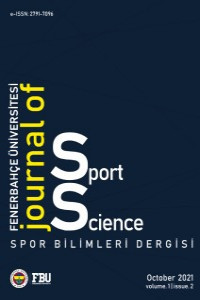Investigation of the Effects of Different Exercise Models on Heart Rate Variability and Muscle Oxygen Saturation
Giriş : Çalışmanın amacı; kürek ve uzun-orta mesafe koşu olmak üzere, farklı vücut bölgeleri baskın (alt ekstremite ve tüm vücut) spor branşlarındaki sporcuların, benzer nabız aralıklarındaki farklı egzersiz modelleri sırasında ve sonrasındaki kalp atım hızı değişkenliği yanıtı ile kas oksijen doygunluğunu incelemektir.
Yöntem : Araştırmaya kürek ve koşu branşlarında yarışan 18 gönüllü erkek sporcu katılmıştır. Sporcular ilk gün kademeli olarak artan bir egzersiz testi ve ikinci günde ise bireysel olarak hesaplanan hedef nabızda 6 dakikalık bir egzersiz testi gerçekleştirmiştir.
Bulgular : Hedef nabız testinde iki grup arasında ilk 2 dakika RR değerleri koşucularda daha yüksektir (p<0.05). İki grup arasında karşılaştırma yapıldığında her iki kasa ait SMO2 değerlerinin 1. dakikada koşu grubunda daha yüksek olduğu saptanmıştır (p<0.05). Test sonrası toparlanma sırasında her iki grubun grup içi RR değerleri ilk 90 saniyede farklılık göstermiştir (p<0.05).
Tartışma : Çalışmanın sonuçları, benzer KAH seviyelerine ulaşılan egzersizlerde, akut toparlanma dönemindeki otonomik kontrol süreçlerinin, farklı egzersiz türleriyle çalıştırılan farklı büyüklükteki kas grupları arasında niteliksel olarak farklı olduğunu göstermektedir. Özellikle toparlanmanın hızlı aşamasındaki RR değerleri, bu görüşü desteklemektedir.
Anahtar Kelimeler:
Kalp Atım Hızı, Kalp Atım Hızı Değişkenliği, Kas Oksijen Doygunluğu, Farklı Egzersiz Türleri
Investigation of the Effects of Different Exercise Models on Heart Rate Variability and Muscle Oxygen Saturation
Introduction : The aim of the study was to investigate heart rate variability response and muscle oxygen saturation during and after different exercise patterns with similar heart rate ranges in athletes of different body region dominant sports (lower extremity and whole body), namely rowing and long-middle distance running.
Method : Eighteen volunteer male athletes competing in rowing and running participated in the study. The athletes performed a gradually increasing exercise test on the first day and a 6-minute exercise test at an individually calculated target heart rate on the second day.
Results : In the target heart rate test, RR values for the first 2 minutes were higher in runners (p<0.05). When a comparison was made between the two groups, it was found that SMO2 values of both muscles were higher in the running group in the 1st minute (p<0.05). During post-test recovery, the intragroup RR values of both groups differed in the first 90 seconds (p<0.05).
Discussion : The results of the study show that the autonomic control processes during the acute recovery period are qualitatively different between muscle groups of different sizes trained with different exercise types in exercises with similar HR levels. RR values, especially during the fast phase of recovery, support this view.
Keywords:
: Heart Rate, Heart Rate Variability, Muscle Oxygen Saturation, Different Types of Exercise,
___
- Borresen J, Lambert MI. (2008). Autonomic Control of Heart Rate during and after Exercise. Sports Med. 38, 633–646.
- Bourdin M, Messonnier L. (2004). Laboratory blood lactate profile is suited to on water training monitoring in highly trained rowers. J Sports Med Phys Fitness, 44(4): 337-41.
- Buchheit M, Chivot A, Parouty J. (2010) Monitoring endurance running performance using cardiac parasympathetic function. Eur J Appl Physiol. 108, 1153–1167.
- Başlangıç: 2021
- Yayıncı: Fenerbahçe Üniversitesi
